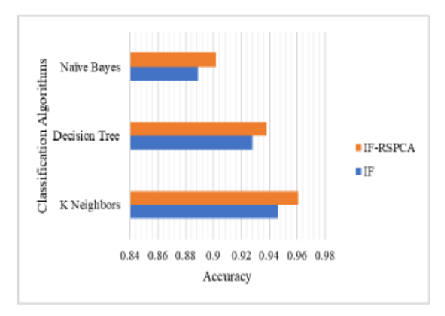


Indian Journal of Science and Technology
Year: 2023, Volume: 16, Issue: 29, Pages: 2244-2251
Original Article
T M Prajesha1*, S Veni2
1Research Scholar, Department of Computer Science, Karpagam Academy of Higher Education, Coimbatore, 641 021, Tamil Nadu, India
2Professor, Department of Computer Science, Karpagam Academy of Higher education, Coimbatore, 641 021, Tamil Nadu, India
*Corresponding Author
Email: [email protected]
Received Date:19 March 2023, Accepted Date:03 July 2023, Published Date:05 August 2023
Objectives: To develop a model for the prediction of anxiety disorder. Presence of outliers may affect the model performance. Hence, here the main consideration is the removal of outliers. Methods: This study proposed an outlier detection method IF-RSPCA in which outliers are handled in two phases. In the first phase, reduce the impact of outliers by using Inter Quartile Range (IQR), then dimensionality reduction is done using principal component analysis. Training time can be reduced by Principal Component Analysis. In the second phase of IF-RSPCA, check the outliers for still exist and removed. Findings: For the performance evaluation two datasets are generated; one using conventional isolation forest and the other using IFRSPCA. Performance of both datasets are tested using K Neighbors, Decision Tree and Naïve Bayes classifiers, highest accuracies are obtained as 96.10 %,93.80% and 90.2%, respectively. It is found that the dataset generated using proposed method performed well. As compared to previous works on survey datasets, the proposed model is capable of identifying the anxiety, more accurately. Novelty: Conventional isolation forest algorithm is modified using Inter Quartile Range there by improve the performance measures. It helps to removes all the outliers completely. The previous models for the predictions of anxiety disorder are developed without performing the outlier detection; hence chances of misclassification exist. In several previous works, isolation forest combined with clustering, but it is not capable of removing all the outliers. In these cases, outlier handling is performed in a single phase only.
Keywords: Principal Component Analysis; Isolation Forest; Robust Scaling; K Nearest Neighbors; Decision tree
© 2023 Prajesha & Veni. This is an open-access article distributed under the terms of the Creative Commons Attribution License, which permits unrestricted use, distribution, and reproduction in any medium, provided the original author and source are credited. Published By Indian Society for Education and Environment (iSee)
Subscribe now for latest articles and news.